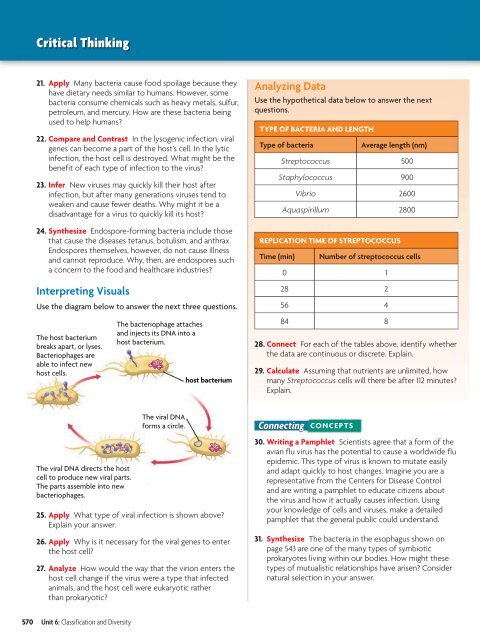18.1 Studying Viruses and Prokaryotes
18.1 Studying Viruses and Prokaryotes
18.1 Studying Viruses and Prokaryotes
Create successful ePaper yourself
Turn your PDF publications into a flip-book with our unique Google optimized e-Paper software.
Critical Thinking21. Apply Many bacteria cause food spoilage because theyhave dietary needs similar to humans. However, somebacteria consume chemicals such as heavy metals, sulfur,petroleum, <strong>and</strong> mercury. How are these bacteria beingused to help humans?22. Compare <strong>and</strong> Contrast In the lysogenic infection, viralgenes can become a part of the host’s cell. In the lyticinfection, the host cell is destroyed. What might be thebenefit of each type of infection to the virus?23. Infer New viruses may quickly kill their host afterinfection, but after many generations viruses tend toweaken <strong>and</strong> cause fewer deaths. Why might it be adisadvantage for a virus to quickly kill its host?24. Synthesize Endospore-forming bacteria include thosethat cause the diseases tetanus, botulism, <strong>and</strong> anthrax.Endospores themselves, however, do not cause illness<strong>and</strong> cannot reproduce. Why, then, are endospores sucha concern to the food <strong>and</strong> healthcare industries?Interpreting VisualsUse the diagram below to answer the next three questions.The host bacteriumbreaks apart, or lyses.Bacteriophages areable to infect newhost cells.The bacteriophage attaches<strong>and</strong> injects its DNA into ahost bacterium.host bacteriumAnalyzing DataUse the hypothetical data below to answer the nextquestions.TYPE OF BACTERIA AND LENGTHType of bacteriaAverage length (nm)Streptococcus 500Staphylococcus 900Vibrio 2600Aquaspirillum 2800REPLICATION TIME OF STREPTOCOCCUSTime (min)Number of streptococcus cells0 128 256 484 828. Connect For each of the tables above, identify whetherthe data are continuous or discrete. Explain.29. Calculate Assuming that nutrients are unlimited, howmany Streptococcus cells will there be after 112 minutes?Explain.The viral DNA directs the hostcell to produce new viral parts.The parts assemble into newbacteriophages.The viral DNAforms a circle.25. Apply What type of viral infection is shown above?Explain your answer.26. Apply Why is it necessary for the viral genes to enterthe host cell?27. Analyze How would the way that the virion enters thehost cell change if the virus were a type that infectedanimals, <strong>and</strong> the host cell were eukaryotic ratherthan prokaryotic?Connecting CONCEPTS30. Writing a Pamphlet Scientists agree that a form of theavian flu virus has the potential to cause a worldwide fluepidemic. This type of virus is known to mutate easily<strong>and</strong> adapt quickly to host changes. Imagine you are arepresentative from the Centers for Disease Control<strong>and</strong> are writing a pamphlet to educate citizens aboutthe virus <strong>and</strong> how it actually causes infection. Usingyour knowledge of cells <strong>and</strong> viruses, make a detailedpamphlet that the general public could underst<strong>and</strong>.31. Synthesize The bacteria in the esophagus shown onpage 543 are one of the many types of symbioticprokaryotes living within our bodies. How might thesetypes of mutualistic relationships have arisen? Considernatural selection in your answer.570 Unit 6: Classification <strong>and</strong> Diversity
















